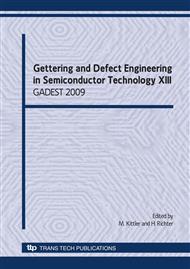p.511
p.517
p.523
p.529
p.535
p.541
p.547
p.555
p.561
Feedback Effect on the Self-Organized Nanostructures Formation on Silicon upon Femtosecond Laser Ablation
Abstract:
The role of multi-pulse feedback in self-organized nanostructure (ripples) formation on silicon surface upon femtosecond laser ablation is investigated. For irradiation at constant intensity and pulse repetition rate, the previously postulated feedback effect of accumulated dose with in¬creasing number of pulses is confirmed and investigated in detail: both the modified surface area as well as the complexity and feature size of generated nanostructures increase with accumulated dose. More interestingly, at constant total incident dose (number of pulses times pulse energy) accumu¬lation and feedback depend strongly on temporal pulse separation. The feedback becomes increas¬ingly weaker with increasing time intervals between successive pulses, involving times up to one second and more before individual pulses act independently. In a first attempt to model this long-lived coupling, we find that conduction band electrons, produced by the preceding laser pulse, can provide, indeed, such feedback by facilitating coupling of subsequent pulses for substantial delays. However, the achieved time span of about a millisecond is still significantly shorter than observed experimentally.
Info:
Periodical:
Pages:
535-540
Citation:
Online since:
October 2009
Authors:
Price:
Сopyright:
© 2010 Trans Tech Publications Ltd. All Rights Reserved
Share:
Citation:


